The Intel Broadwell Review Part 2: Overclocking, IPC and Generational Analysis
by Ian Cutress on August 3, 2015 8:00 AM ESTGaming Benchmarks: High End
At the top of the line we take the best GPUs on the market from May 2015 - an AMD R9 290X and an NVIDIA GTX 980.
Alien: Isolation
If first person survival mixed with horror is your sort of thing, then Alien: Isolation, based off of the Alien franchise, should be an interesting title. Developed by The Creative Assembly and released in October 2014, Alien: Isolation has won numerous awards from Game Of The Year to several top 10s/25s and Best Horror titles, ratcheting up over a million sales by February 2015. Alien: Isolation uses a custom built engine which includes dynamic sound effects and should be fully multi-core enabled.
For low end graphics, we test at 720p with Ultra settings, whereas for mid and high range graphics we bump this up to 1080p, taking the average frame rate as our marker with a scripted version of the built-in benchmark.
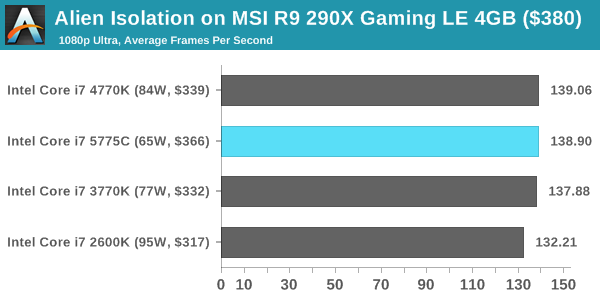
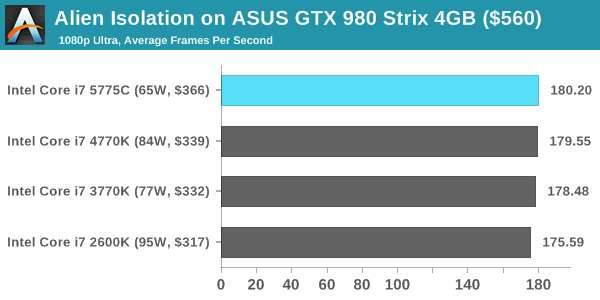
Total War: Attila
The Total War franchise moves on to Attila, another The Creative Assembly development, and is a stand-alone strategy title set in 395AD where the main story line lets the gamer take control of the leader of the Huns in order to conquer parts of the world. Graphically the game can render hundreds/thousands of units on screen at once, all with their individual actions and can put some of the big cards to task.
For low end graphics, we test at 720p with performance settings, recording the average frame rate. With mid and high range graphics, we test at 1080p with the quality setting. In both circumstances, unlimited video memory is enabled and the in-game scripted benchmark is used.
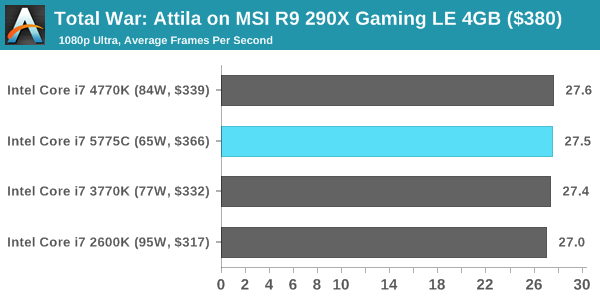

Grand Theft Auto V
The highly anticipated iteration of the Grand Theft Auto franchise finally hit the shelves on April 14th 2015, with both AMD and NVIDIA in tow to help optimize the title. GTA doesn’t provide graphical presets, but opens up the options to users and extends the boundaries by pushing even the hardest systems to the limit using Rockstar’s Advanced Game Engine. Whether the user is flying high in the mountains with long draw distances or dealing with assorted trash in the city, when cranked up to maximum it creates stunning visuals but hard work for both the CPU and the GPU.
For our test we have scripted a version of the in-game benchmark, relying only on the final part which combines a flight scene along with an in-city drive-by followed by a tanker explosion. For low end systems we test at 720p on the lowest settings, whereas mid and high end graphics play at 1080p with very high settings across the board. We record both the average frame rate and the percentage of frames under 60 FPS (16.6ms).
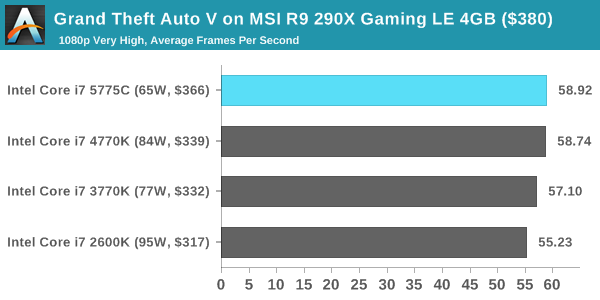
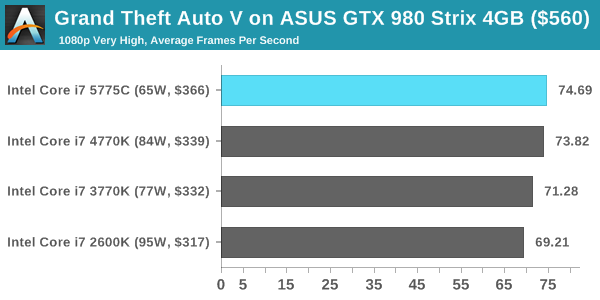
GRID: Autosport
No graphics tests are complete without some input from Codemasters and the EGO engine, which means for this round of testing we point towards GRID: Autosport, the next iteration in the GRID and racing genre. As with our previous racing testing, each update to the engine aims to add in effects, reflections, detail and realism, with Codemasters making ‘authenticity’ a main focal point for this version.
GRID’s benchmark mode is very flexible, and as a result we created a test race using a shortened version of the Red Bull Ring with twelve cars doing two laps. The car is focus starts last and is quite fast, but usually finishes second or third. For low end graphics we test at 1080p medium settings, whereas mid and high end graphics get the full 1080p maximum. Both the average and minimum frame rates are recorded.
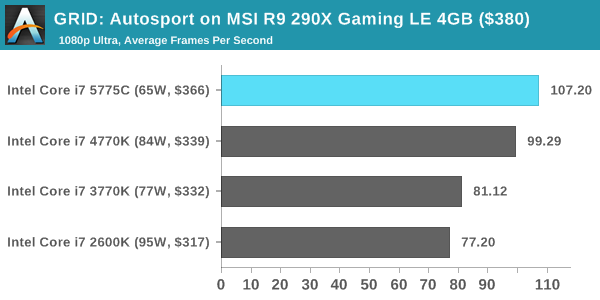
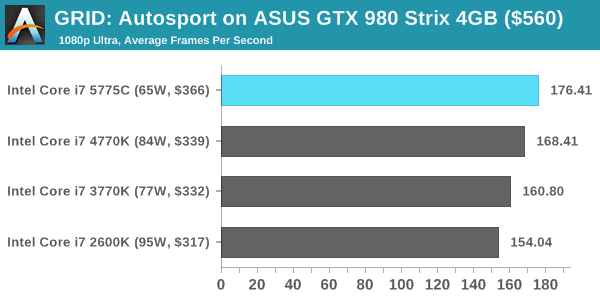
Middle-Earth: Shadows of Mordor
The final title in our testing is another battle of system performance with the open world action-adventure title, Shadows of Mordor. Produced by Monolith using the LithTech Jupiter EX engine and numerous detail add-ons, SoM goes for detail and complexity to a large extent, despite having to be cut down from the original plans. The main story itself was written by the same writer as Red Dead Redemption, and it received Zero Punctuation’s Game of The Year in 2014.
For testing purposes, SoM gives a dynamic screen resolution setting, allowing us to render at high resolutions that are then scaled down to the monitor. As a result, we get several tests using the in-game benchmark. For low end graphics we examine at 720p with low settings, whereas mid and high end graphics get 1080p Ultra. The top graphics test is also redone at 3840x2160, also with Ultra settings, and we also test two cards at 4K where possible.
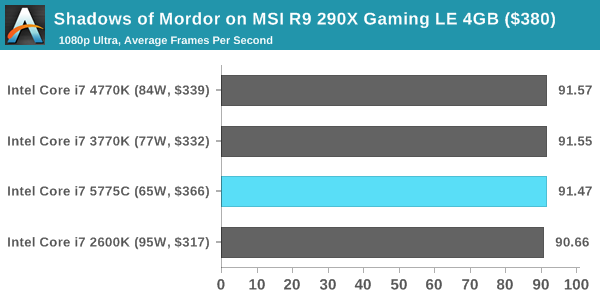
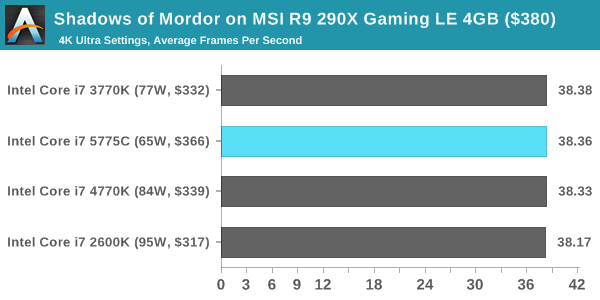
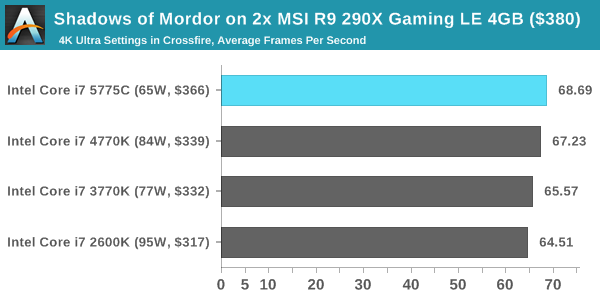
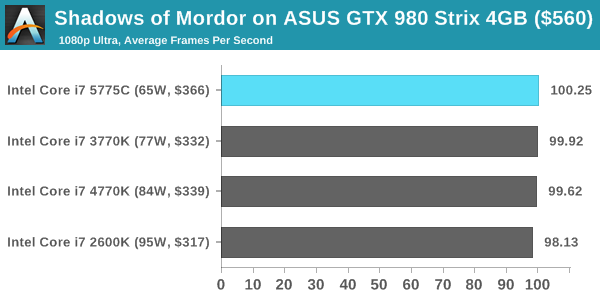
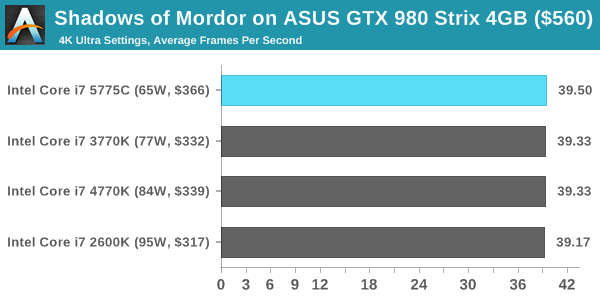
















121 Comments
View All Comments
name99 - Monday, August 3, 2015 - link
Well think about WHY these results are as they are:- There is one set of benchmarks (most of the raytracing and sci stuff) that can make use of AVX. They see a nice boost from initial AVX (implemented by routing each instruction through the FPU twice) to AVX on a wider execution unit to the introduction of AVX2.
- There is a second set of benchmarks (primarily winRAR) that manipulate data which fits in the crystalwell cache but not in the 8MB L3). Again a nice win there; but that's a specialized situation. In data streaming examples (which better described most video encode/decode/filtering) that large L4 doesn't really buy you anything.
- There WOULD be a third set of benchmarks (if AnandTech tested for this) that showed a substantial improvement in indirect branch performance going from IB to Haswell. This is most obvious on interpreters and similar such code, though it also helps virtual functions in C++/Swift style code and Objective C method calls. My recollection is that you can see this jump in the GeekBench Lua benchmark. (Interestingly enough, Apple's A8 seems to use this same advanced TAGE-like indirect predictor because it gets Lua IPC scores as good as Intel).
OK, no we get to Skylake. Which of these apply?
- No AVX bump except for Xeons.
- Usually no CrystalWell
So the betting would be that the BIG jumps we saw won't be there. Unless they've added something new that they haven't mentioned yet (eg a substantially more sophisticated prefetcher, or value prediction), we won't even get the small targeted boost that we saw when Haswell's indirect predictor was added. So all we'll get is the usual 1 or 2% improvement from adding 4 or 6 more physical registers and ROB slots, maybe two more issue slots, a few more branch predictor slots, the usual sort of thing.
There ARE ideas still remaining in the academic world for big (30% or so) improvements in single-threaded IPC, but it's difficult for Intel to exploit these given how complex their CPUs are, and how long the pipeline is from starting a chip till when it ships. In the absence of competition, my guess is they continue to play it safe. Apple, I think, is more likely to experiment with these ideas because their base CPU is a whole lot easier to understand and modify, and they have more competition.
(Though I don't expect these changes in the A9. The A7 was adequate to fight off the expected A57; the A8 is adequate to fight off the expected A72; and all the A9 needs to do to maintain a one year plus lead is add the ARMv81.a ISA and the same sort of small tweaks and a two hundred or so MHz boost that we saw applied to the A8. I don't expect the big microarchitectural changes at Apple until
- they've shipped ARMv81.a ISA
- they've shipped their GPU (tightly integrated HSA style with not just VM and shared L3, but with tighter faster coupling between CPU and GPU for fast data movement, and with the OS able to interrupt and to some extent virtualize the GPU)
- they're confident enough in how wide-spread 64-bit apps are that they don't care about stripping out the 32-bit/thumb ISA support in the CPU [with what they implies for the pipeline, in particular predication and barrel shifter] and can create a microarchitecture that is purely optimized for the 64-bit ISA.
Maybe this will be the A10, IF the A9 has ARMv8.1a and an Apple GPU.)
Speedfriend - Tuesday, August 4, 2015 - link
"The A7 was adequate to fight off the expected A57;"In hindsight the A7 was not very good at all, it was the reason that Apple was unable to launch a large screen phone with decent battery life. Look at he improvements made to A8, around 10% better performance, but 50% more battery life.
Speedfriend - Tuesday, August 4, 2015 - link
"they've shipped their GPU" by the way, why do you expect them to ship their own GPU and not use IMG's. The IMG GPU have consistently been the best in the market.nunya112 - Monday, August 3, 2015 - link
by the looks of it. the 4790K seems to be the best CPU. until skylake that is. but even then I doubt there will be much improvementnunya112 - Monday, August 3, 2015 - link
unless u have the older ivy's then yeah maybe worth it ?TheinsanegamerN - Monday, August 3, 2015 - link
Nah. the older ivys can be overclocked to easily meet these chips. the IPC of broadwell is overshadowed by a 400mhz lower clock rate on typical OC. only reason to upgrade is if you NEED something on the new chipset or are running some nehalem-era chip.Teknobug - Monday, August 3, 2015 - link
Ivy's are the best overclockers.TheinsanegamerN - Monday, August 3, 2015 - link
Sandy overclocked better than ivy,Hulk - Monday, August 3, 2015 - link
Ian - Very nice job on this one! Thanks.Meaker10 - Monday, August 3, 2015 - link
A slight correction, on the image of crystal well it is the die on the left (the much larger one) which is the cache and the small one is the cpu on the right.